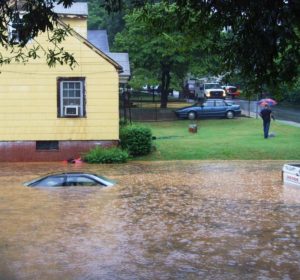When what was left of Hurricane Florence arrived in Charlotte, North Carolina on September 15, 2018, Justin Parmenter was very grateful to his county government. He was one of thousands of local residents who used to live on one of Charlotte’s flood-prone creeks. His family spent years replacing water-damaged carpets, appliances and vehicles at a cost his schoolteacher salary couldn’t afford.
He tried many times to sell his house for the $80,000 balance of his mortgage, but couldn’t find a dumb-enough buyer. Then he found one who paid him $100,000, and the buyer was far from stupid. It was Mecklenberg County, and their disaster resilience strategy was simple: buy properties that never should have been developed in the first place, and never again let anyone build there.
There are 19,841 acres of land designated as floodplain in Mecklenburg County, which includes the communities of Charlotte, Cornelius, Davidson, Huntersville, Matthews, Mint Hill, and Pineville. Floodplains are the areas along streams or rivers that are likely to experience repeated flooding.
Over thousands of years, nature shaped the floodplain to hold excess water that spills over the banks. Simply put, floodplains are meant to flood. Because nature designed floodplains to flood, the floodplain system is considered to be part of a healthy watershed.
Over 20,000 parcels of land in the county are in or affected by the floodplain, representing 5% of land in the county. Approximately 2,900 habitable and accessory structures are located in the floodplain. Although many of these homes and business are built above the 100-year flood level, many are now impacted regularly as a result of climate change.
“I’ve always been so grateful to them,” Parmenter told Bloomberg Businessweek from the dry comfort of their home. “I was desperate to get out of that house.” Such intelligence in city and county governments is unfortunately rare. Many other municipalities continue to take advantage of the perverse incentives of the National Flood Insurance Program, which rewards people for making the same dumb mistakes, decade after decade. In actual fact, the federal program does help communities buy flood-prone properties. But it’s both under-funded and slow, often taking 5 years to close each deal.
Sea level rise and climate change-magnified storms are working hard to destroy Miami, New York City and Houston, yet all three cities are building like crazy along their waterfronts. Unfortunately, some of these are otherwise-wonderful revitalization projects, like the Brooklyn Navy Yard and Washington DC’s Navy Yard.
Climate experts, like Joel Scata, an attorney at the Natural Resources Defense Council, are calling Mechlenberg’s strategy a blueprint for the entire nation. “As flood risks continue to worsen throughout the U.S. because of climate change, you’re going to see a real need for really novel approaches,” he said in that same Bloomberg Businessweek article. “The Charlotte-Mecklenburg approach is a great example of that.”
How do they pay for the buyout program? Simple: Charlotte-Mecklenburg Storm Water Services adds $1.25 per month to every resident’s water bill. It yields some $3 million annually to purchase and demolish about 24 houses. They even have a “quick-buy” feature that makes offers immediately after a flood, when flood plain homeowners’ priorities have been accurately re-calibrated.
But not everyone takes the county up on its wise offer. For those few remaining flood plain residents, the only thing more terrifying than a flood is change. What’s more, many of them prefer not having so many neighbors: it’s like living in a park.
Timothy Trautman runs the buyout program in his role as manager of engineering and mitigation at the Charlotte-Mecklenburg Storm Water Services. He explains that the buyouts also cut rescue expenses, not to mention reducing life-threatening risks to emergency responders.
Buying and removing buildings in the floodplain is one of the most cost-effective ways to reduce long-term flood damage and create many other community benefits. Floodplain acquisitions provide the community recreational and open space assets. Over time, the local building stock shifts from older buildings in vulnerable areas, to newer code-compliant buildings in more sustainable locations within Mecklenburg County.
Since 1999, Storm Water Services has purchased over 400 flood-prone houses, apartment buildings and businesses that were in floodplains throughout Charlotte-Mecklenburg. Over 700 families and businesses have moved to less vulnerable locations outside of local floodplains. 185 acres of public open space has been “undeveloped” to allow the floodplain to function during heavy rain and provide a long term community asset. Storm Water Services also estimates these buyouts have avoided $25 million in losses and will ultimately avoid over $300 million in future losses.
Floodplain buyouts have all been voluntary. Owners are not forced to sell. Historically, about 85% of owners who go through the appraisal/offer process, participate in the buyout.
The first 12 years of the program were funded exclusively through Federal grants with local matching funding. Currently, the annual investment in buyouts is $4 million and most buyouts are funded completely with local money. The program also coordinates acquisitions with other public entities to achieve multi-objective goals.
The county’s intelligence isn’t a recent phenomenon, either. Since 1999, the buyout program has invested $67 million in removing buildings from the floodplain (43% federal, 2% state, 48% local, 7% other). They have their eye on up to 1000 more, before the program can be considered substantially complete.
Let’s hope that such intelligent governance is contagious, though there’s little evidence of that in this country to date…it seems to be a recessive gene in today’s politicians. Some learning-resistant governments have even made it illegal for their employees to base their decisions on science and facts. They prefer to rely in blind faith in the fossil fuel companies’ criminally-irresponsible propaganda that climate change is a global scientific conspiracy.
The place to start is the National Flood Insurance Program (NFIP), as mentioned earlier. The NFIP was designed to help Americans recover from flood disasters, but it can also unintentionally trap homeowners who would prefer to move somewhere safer. Instead of moving out of harm’s way, many policyholders find themselves rebuilding their homes again and again.
In the face of climate change and rising flood risks and damages, the NFIP should provide interested homeowners the option of relocating. This issue brief proposes flood insurance reforms that would make it possible for the owners of repeatedly flooded homes to receive a buyout of their property after a flood, removing the uncertainty that surrounds the Federal Emergency Management Agency’s existing buyout efforts.
Another leverage point would be to make it easier to Americans to avoid buying properties in flood-prone locations. Millions of Americans live in homes at risk of flooding, and a home that has flooded once is likely to get hit again. Unfortunately, it’s extremely difficult for a home buyer to learn of a property’s flood history. Many states do not require sellers to tell prospective home buyers whether a property has been damaged by a flood. Limiting access to such information prevents people from making smart decisions about where to live. The NRDC is working to fix this with a Flood Disclosure Map (see link below.)
Lastly, we need better funding of renovation efforts to create resilient water infrastructure. Again, the NRDC is working on that. They published a report in May of 2018 to address the problem. The funding gap for U.S. water infrastructure could exceed $1 trillion.
Many decades-old drinking water, wastewater, and stormwater systems do not meet existing environmental and public health standards. Even more systems will need to be modernized to continue to meet these standards. Furthermore, our water infrastructure was never designed for the impacts of climate change, including the increasing frequency of droughts and sea level rise, so many existing systems will need to be redesigned or relocated.
The NRDC report describes actions that federal and state governments should take to generate more funding for water infrastructure through State Revolving Funds (SRFs). Increased funding is needed to
- build climate resilient water infrastructure;
- support green infrastructure;
- invest in water efficiency;
- expand source water protection efforts;
- replace lead service lines; and
- provide much-needed assistance to low-income communities.
These recommendations could help shrink the nation’s water infrastructure funding gap in a way that’s sustainable and equitable. It would also provide assistance for communities most in need, and help build the 21st century water infrastructure systems the entire nation needs.
See Charlotte-Mecklenburg Storm Water Services buyout program website.
See NRDC’s 2017 report on reforming the NFIP: “Seeking Higher Ground”.
See NRDC’s Flood Risk Disclosure Report Card for U.S. states.
See 2018 NRDC report on funding resilient water infrastructure.
See Mecklenberg County website.
See article by Christopher Flavelle in Bloomberg BusinessWeek.




